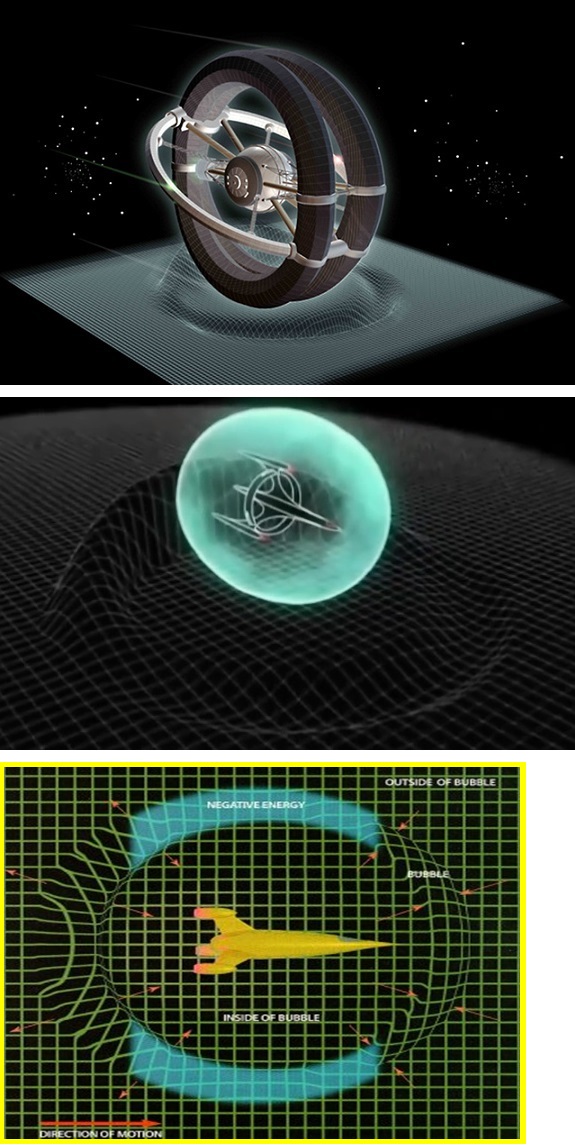
1. The FTL capable Alcubierre Drive (Status: Speculative)
The idea originated from the Mexican scientist "Miguel Alcubierre", somewhere around 1994.Basically, it's this:
If the speed of light (c) is indeed the maximum speedlimit at which information may travel "through" space-time, then why don't we alter, or modify, space-time itself?
Indeed, for example, a gravitational "wave" may bend, or "ripple" space. Similarly, the idea which Alcubierre formulated, was also based on the theories of Einstein and especially on the Friedmann equations.
If you could compress space in front of your spacecraft, and expand it behind, you could travel "through" space without violating the speedlimit "c". Your "bubble" of space, moves (as it were), by itself, just "along the expansion".
The machine is actually sort of "surfing" space-time.
That's why I made a mistake (in the former sentence) by saying "through space": It should have been "along space".
"The Alcubierre Drive" was put forward as a "faster than light (FTL)" machine.
Since space itself might expand superluminously fast (that's the hypothesis), and given the fact that the drive
"floats" along that same expanding space, Alcubierre proposed it to be a FTL capable machine.
However, it must be noted that FTL is the point where most physicists will "exit this idea", mainly because FTL breaks down "causality".
We must understand that in this model, space itself expands rapidly "behind" the drive, therefore no Field, or particle, exceeds "c".
It effectively says that your private "bubble" has its own local frame of reference, and space around it is completely warped.
Inside your local "bubble" however, remains a portion of flat space-time.
The inhabitants of "the bubble" (people, probes?) will not notice any inertial effects.
As to "how" you could modify space to such an extend (compress in front, expand behind), various approaches exist.
- Altering the "state of the vacuum" is one, and this is where many physicist will probably "close the door" quite rapidly.
- Another line of thinking is to use "negative mass" or "exotic matter", which corresponds to "negative energy" (many folks don't like the "negative energy" phrase).
This is how Alcubierre orginally visualized how it could hypothetically work.
The point is then, that "negative energy" (repulsive pressure) works "repulsive" in the sense to force "space" to expand.
(Note that the idea also resembles some ideas of creating a "wormhole".)
As to why "repulsive pressure" or "negative pressure" might expand space, you might take a look at the following (partial Friedmann) equation which usually applies for the Universe as a whole, under certain conditions.
If we "just" apply it to some local region, then that's actually not so "nice". But, if we do, at least we see some relation about "expansion" (a) and "negative pressure". Read the following explanation:

Here, "ρ" (rho) corresponds to density, and "p" corresponds to pressure.
(a) is a "measure" for the "expansion".
Now, if we have indeed have negative pressure "p", we then might get ρ + 3p/c2 < 0, which makes the upper equation for "a" positive, so then it follows that we have a positive expansion.
Ok, the argument and usage of the equation is not "completely healthy", but my sole purpose was to make clear, that relations exists between "pressure" and space expansion. But maybe you are a physicist and now you just planned to pay me a visit and punch me on the nose.
However, unfortunately, in the Alcubierre concept, it seems that an abnormal amount of energy is required, ranging from the order of a solar mass, to something like the energy equivalent of Jupiter (depending on the calculation).
While we still have no way to create negative mass (or energy), it's not looking very good for the drive...
As another obstacle, from a more practical viewpoint, many engineers say that such a device cannot be controlled, and the tidal forces and radiation close to the spacecraft would be so immensly great, that absolutely no "thing" in nature can survive it.
Therefore, almost all physicists view the "The Alcubierre Drive" as a nice theoretical exercise, but no more than that.
Note: That the concept is truly a good exercise, is the fact that the concept in relation to "causality", yields facinating ideas, on which (I hope) you "google" further.
Interestingly, and quite recently, a researcher at Nasa (Harold White) is performing (let's say) small scale investigations. The aim is to construct a practical experiment to investigate the existence of Alcubierre drive effects (warping space). If you want, you can find some of his ideas here (pdf file).
Some theoretical work continues too. So, the concept is certainly not dead, and who knows? Maybe the future holds some surprises for us...
Figures on the left-side: A ring, or donut shaped band of "negative energy" shapes space, so the spacecraft effectively
rides along the expansion of space, therefore (as it was assumed) not violating Einstein's Relativity Principles.
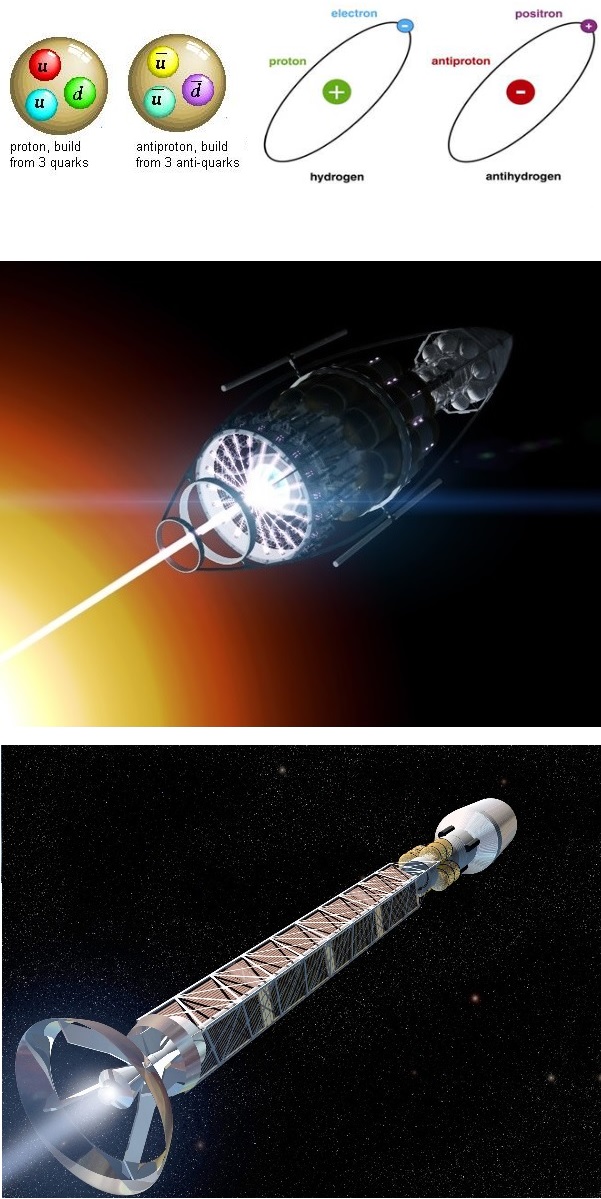
2. The Anti Matter Drive (Status: Theoretical)
Elementary particles, have a sort of "opposite" twin, called the "anti particle" for that elementary particle.For example, we have the "positron" (anti-electron) for the "electron", and the "anti-proton" for the "proton".
Anti particles can be observed at high-energy collisions between common elementary particles, and at some natural processes, like in "cosmic rays".
In the figure on the left, you may find a few illustrations of "anti matter".
When a particle and it's anti-particle meet, annihilation will occur, resulting in high-energy radiation (and sometimes also with lower mass particles).
Simply put: When a particle and an anti-particle "meet", they destroy each other, giving pure energy. Almost all mass get's converted to energy, according to one of Einsteins famous equations "E=mc2.
And even "anti-atoms" are possible, like "anti-Hydrogen", which is similar to the normal Hydrogen atom, only this time with an anti-electron and an anti-proton.
In "larger quantities", it is the most "explosive" stuff we know of. The following sounds a bit nasty, but is for illustrational purposes only:
Suppose you would have only 1 gram of anti-matter: one gram of antimatter annihilating with one gram of normal matter, produces an energy equivalent to just over 43 kilotons of TNT ! That would be a pretty impressive atombomb.
Could it ever serve as a propellant for a spaceship? Well, most scientists will quickly point to the fact that up to this very day, only incredably small amounts have been produced, in the order of nano-grams. And, "storage" of anti-matter is no easy task as well.
Since matter and anti-matter will immediately annihilate, only devices like "magnetic" bottles and similar "traps" have succesfully stored extremely small quantities of anti-matter.
So, up to this day, it does not look too good for using it as a source for energy.
However, the "anti-Hydrogen" atoms are already proven to be possibly good cadidates for longer term storage, and in larger quantities.
There is a lot of research going in that field.
The "antimatter spacecraft", is "conventional" in the sense that a "regular" thrust is used (quite contrary to, for example, the Alcubierre Drive). Indeed, this time, the "antimatter" spacecraft has a lot in common with "a normal" conventional rocket, except for the "type of fuel". So, here we have a machine, or rocket, that travels "through" space in a normal way, instead of "manipulating space" (like the Alcubierre Drive did).
The conventional rocket, applies an acceleration to itself (a thrust), by expelling the "gas products" of the chemical process (the burning), so the rocket experiences an opposite Force, due to the conservation of momentum (often it's a sort of momentum transfer of the hot and fast gasses to the parabolic nozzle).
See appendix 1 for some more information on conventional (chemical) rockets.
Now for antimatter: Antimatter propulsion, applied and used for "thrust", has the best mass-energy conversion ratio
compared to any other "thinkable" propellant.
The anti-matter spacecraft is not a "faster than light" machine. In that sense, it's a conventional machine, but with a revolutionary drive. A large number of publications can be found with "reasonable" calculations. It's safe to say, that with an "optimal" design, it could reach a relevant percentage of the speed of light. To give an extreme number anyway: say 0.6 c (or even faster).
Types of antimatter drives:
Actually there are two mainstreams of thoughts:
(1). Really using antimatter as the main propulsion implementation.
This would then encounter all major difficulties and complexities, and such a machine would be tremendously difficult to build. Often, it is envisioned that very small quantities of matter/antimatter are somehow injected close to a magnetic nozzle which then absorbs part of the momentum.
(2). Using (very small quantities) of antimatter, as a sort of "trigger" or "catalyst" for the main type of propulsion, like a nuclear fusion/fission engine, or sort of Plasma drive.
From the literature, (2) is often seen as the most realistic model to implement antimatter for propulsion.
You might "google" further on terms like "ICAN" or "AIMSTAR" in combination with antimatter.
Not withstanding the fact that the complexity of any of such drive is mind-boggling, it's really a fact that a few grams (in principle) gets a machine "going" in our own solar system, and any trip (say for example to Jupiter) must be expressed in weeks (instead of years).
As an Interstellar propulsion technique, it theoretically is one of the best options. Since it is capable for attaining possibly 0.6 c (or maybe even faster), it could really be the one to go for.
Ofcourse, the above is only "sane" if a cost-effective way is found to produce and store relevant quantities of some variant of antimatter, like anti-hydrogen atoms.
If we are realistic (and sadly a bit pessimistic), we are still a long way from any implementation, and maybe it will not happen at all.
But..., can you look 300 years ahead in time? No, too bad... you and I, we can't. But for sure... things will be different then.
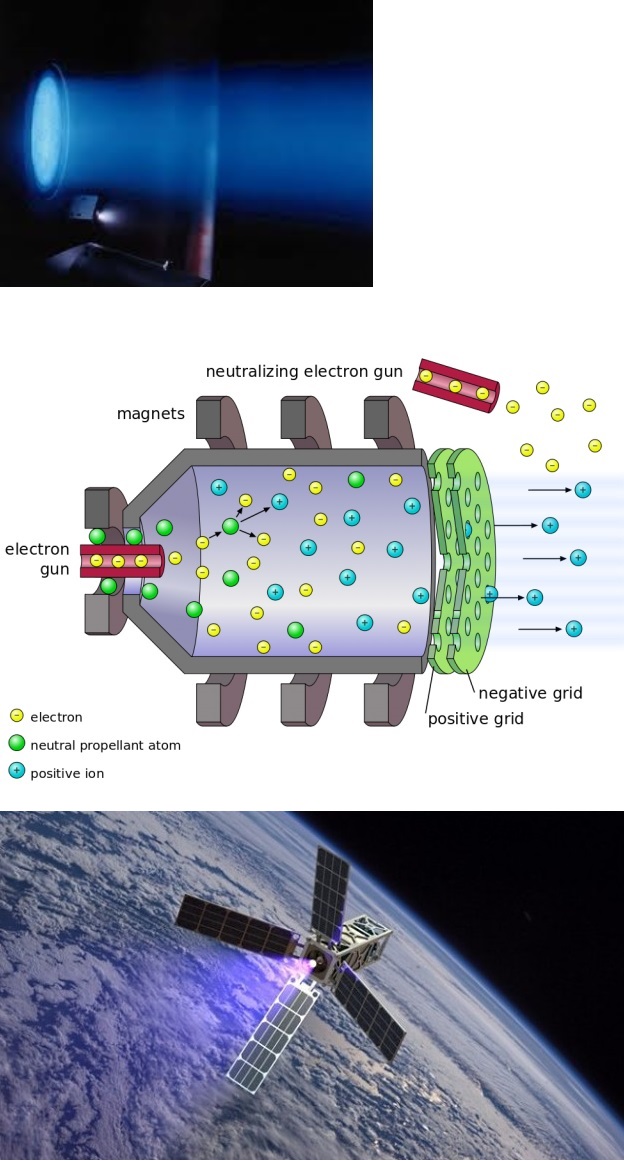
3. The ION Drive (Status: Real)
The ion "drive" also goes by the name "ion thruster", and is sometimes also classified as "Electric Propulsion".And this type of drive is already in operation, in real missions.
First work on this type of propulsion, even goes back to the 60s of the former century (!).
Ofcourse, research will continu, to try to optimize this type of drive.
This section deals with the ion thruster "as is", since ideas on "hybrid versions", e.g. in combination with nuclear power,
already exists too.
We can express the fundamental idea behind it, like so: There is lower thrust, but for a very long time.
Indeed, it may run for weeks, or months, or even longer like years.
Many ion thrusters have been developed in Lab environments, and even put in action in real missions. For example, in some cases, ion thrusters are used to keep communication satellites into the right position.
Another example are a number of interplanetary missions (in our own solar system). One example is the probe "Dawn", launched by NASA in 2007, and which is on it's way to the "Astroid Belt" to visit the astroids "Vesta" and "Ceres".
The "ion thruster" could well a very popular type of engine for near future, especially for smaller unmanned missions. There is a trade-off ofcourse: the low thrust means a small acceleration. So, it must operate for a longer time.
It's not powerfull enough to be launched from Earth on it's own engine. The thrust is simply too low. However, a conventional rocket can bring the spacecraft into orbit, and then the Ion drive can be switched on.
As a typical figure for the output thrust, you may think in the order of 0.5 to 1 Newton, which is indeed very low. But if you apply it for a long time, deep-space missions are certainly possible.
On the left you see some typical illustrations. The upper figure shows the typical "glow" of the ion exaust, which are the accelerated ions.
The figure in the middle shows how the engine works:
Usually, the process starts with a neutral gas (often Xenon), which are ionized by an electron "gun". The ions will then be accelerated using electrostatic or electrodynamic fields. Then, the ions leave the engine while there is a momentum coupling with the field. This results in a small force in the direction where the spacecraft wants to move to.
Technically, there exists quite some differences in the specific design and coupling with the EM field.
So, there are quite a few types of "ion thrusters", like the "Hall effect thrusters", "Pulsed inductive thrusters", and many other types.
Velocity:
As for the velocity that can ultimately be reached, I like to be a bit carefull here. Given a long operational time, it's way better than the conventional (chemical) rocket. However, many documents are quite conservative with respect to the "max" velocity, even if a long operational time is involved.
One important determining factor is the "reaction mass", which is the matter that a ion thruster ejects in order to obtain thrust.
Once you run out of reaction mass, you can no longer accelerate.
Many experimental work is done, and planned, on improvements on all of the subsystems in the ion thruster. So, using optimized gas and Fields, and having a low mass payload, and long operational times, there is no fundamental reason
as to why the ion thruster cannot obtain very high speeds.
It's for sure that highly effective ion thrusters, will open up the Solar system, including the outer regions.
Application:
If one consider the current implementations, the io thruster is well suited for interplanetary missions in our own solar system. For now, it seems a good choice for unmanned missions.
It has the potential too, for true Interstellar missions. However, opinions vary.
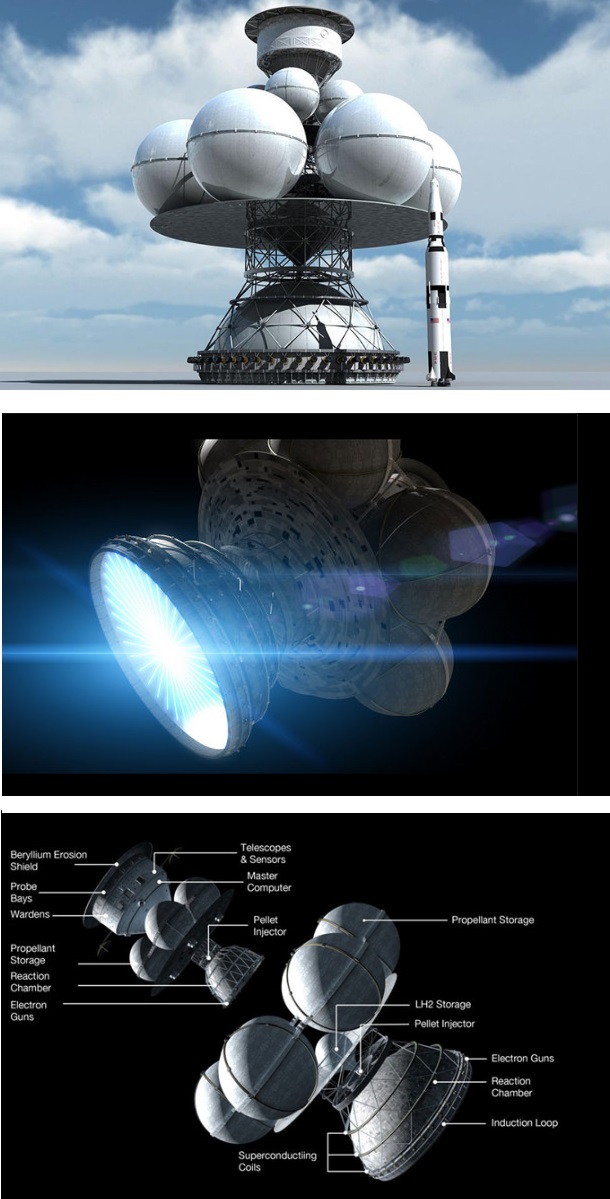
4. Project Daedalus (Status: Theoretical)
This is absolutely a facinating project. "Project Daedalus" was not the first idea, or concept, on using nuclear propulsion (fusion) for Interstellar travel. However, this time, the full concept was decribed, like details on the engine, details on how to construct it, materials needed, the scope of the mission, and a clear plan of all objectives.That the project is massive, can be derived from the fact that the "British Interplanetary Society" started out in 1973, pulled aboard a number of scientists of all sorts of fields, and produced their final "deliverables" in 1978.
In short: prepare an unmanned Interstellar mission, in such a way, that another starsystem can be reached in about 50 years.
It's a "one way" mission, and no return to the Solar system was included.
The missions selected target was Barnard's Star (6 ly away). It's an unmanned mission, using nuclear fusion for propulsion. It's a fully automated and "selfcontained" system (for example, using robots for maintenance and repairs).
It was further so calculated, that the effective cruising speed would be about 12% of the speed of light, so in order to arrive to Barnard's star, indeed something in the order of 50 years was needed. No decelleration was included in the mission.
Large Optical- and Radio telescopes were part of the scientific payload, which would start investigating the sytem about halfway the mission.
Short for arrival, a number of probes would be launched, which would perform a "fly-by" manoeuvre at the Planet(s) of the system.
Why Barnard's Star?:
Barnard's Star is a smaller "red dwarf star", about 6 light-years away from our Solar system. Although the Alpha Centauri is somewhat closer to the Sun (about 4.2 lightyears), it was believed that Barnard's Star was of more interest. First, it was suspected (at that time) it had one or more planets (gas giants) circling around it (later on, that could not be established for a fact).
Secondly, it's the second closest Star to the Sun (the Centauri system is the nearest), so that fact made it a feasable target given the wish that maximum time of travel should not exceed 50 years.
Also, do not forget that Barnard's Star is an M type dwarf, which are very abundant in the Milky way, and are assumed to be very old. All facts together, produced Barnard's Star as the mission's target (where the "short" distance of 6 ly was probably the most decisive factor).
Suggestion: go to Appendix 4, and take a look at those starmaps. Then, search for Barnard's star.
The Machine:
The figures on the left should give you some impression on what group had in mind.
No doubt it's a giant structure. It should be build in orbit around the Earth. Note that it's a two-stage spacecraft.
Actually it's an implementation of pulsed nuclear propulsion. A stream of small Deuterium-Helium3 "pellets" would be injected in the "Reaction Chamber" (see the third figure), and would be instaniously bombarded by electron guns (or powerful lasers), whereas immediately such pellet would explode into a plasma, interacting with the magnetic nozzle, thus providing for thrust (and to a smaller amount reclaiming energy by an electromagnetic coiling system).
And the energy "per pellet" is so high, that a significant increase in speed is realized, plus energy gained to keep the electron guns (or lasers) going.
It was calculated that the first stage of the machine, would accelerate the machine to about 7.1% of lightspeed. The lighter second stage, would then decouple, and ultimately bring the spacecraft to its cruising speed of 12% of the speed of light. The first and second stages would operate for about 3.5 years, meaning that well over 45 years, the spacecraft remained in force-free motion to it's target.
Building the machine would take decades, and an immensly amount of resources. However, it is viewed by many as a "Proof Of Concept" that a large Interstellar mission, at a very large speed, is possible.
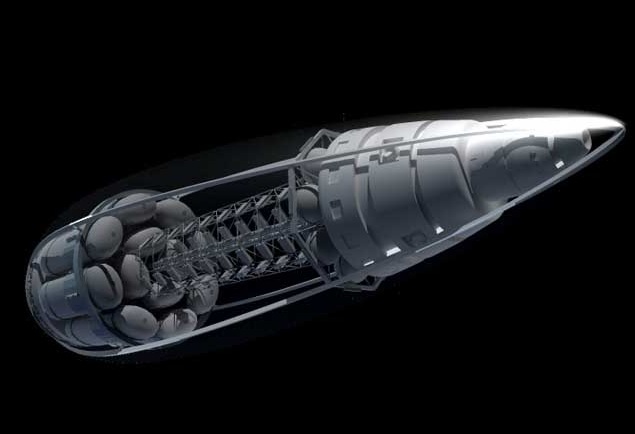
5. Project Icarus (Status: Theoretical)
Project Icarus is actually the successor of Project Daedalus (see section 4).While Daedalus is indeed a "complete project", it stems from the 70s ('73-'78). So, some folks felt that Daedalus needed an "update", since technology and insights changed significally since the '70s, that's why "Project Icarus" started in 2009.
At their website (http://www.icarusinterstellar.org), they have a nice "Frequently Asked Questions" page, which also addresses their mission statement:
The mission of Icarus Interstellar, is to realize interstellar flight before the year 2100.
At this point, they still see a form of "pulsed nuclear fusion" as the most feasable form of propulsion, just like project Daedalus did. Also, it's likely to be an unmanned mission too.
Also, like Daedalus, they probably will select a near-by Star (see appendix 3) as the target, but there is not one selected yet. As such, Project Icarus seems to keep all options open.
It's reasonable to say that the project is in it's "evaluation phase", and probably will remain there for quite some time, discussing and evaluation any current and foreseeable developments.
Ofcourse the team Icarus members are aware that the social, political and economic climate today, is far from optimal to talk about extremely costly Starship missions. So, "promoting" the idea (and stressing on the benefits) is part of their policy too.
Noteworthy further, is that the project already speaks of a much "slimmer" design of the spacecraft, in comparison with Daedalus, mostly due to uncertainties of Interstellar dust, which might indeed be a threat for all Interstellar Missions.
Furthermore, the project still sees (after an accelerating period of some years), a cruising (force-free) speed of around 0.1 c (10% of the speed of light) as realistic.
Also notice, that, at least for now, an "anti-matter" based form of propulsion, is not "The #1" on their list.
We can be sure of the fact that very clever people are associated with Icarus, so that gives us an idea too about the current thoughts on the status and feasability of an "anti-matter" based drive in the medium term future (up to, say, the year 2100).
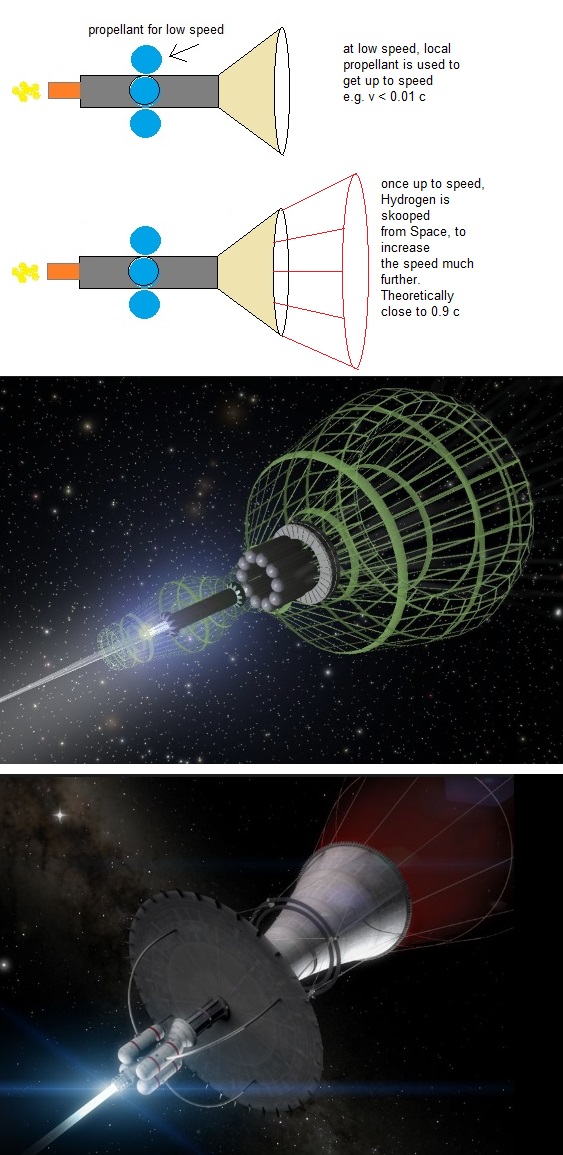
6. Bussard ramjet (Status:Theoretical, maybe impossible.)
From "propellant-economic" perspective, the "Bussard Ramjet" is no less than a brilliant concept.And, it's a machine which theoretically might achieve an incredable velocity like 0.7 c (or maybe even higher).
However, there are likely to exist some serious "flaws" in the current design, as many articles suggest.
Wouldn't it be great to "scoop" the propellant from space itself? The idea is based on capturing Hydrogen, or ionized Hydrogen, from interstellar space, using large Electromagnetic fields in front of the spacecraft.
This field would function like a funnel, "conducting" the Hydrogen with high speed into a Reaction Chamber. As people often say: it acts and looks like a ram scoop.
These fields might be streched over tens- or maybe hunderds of miles (or even more), covering a huge surface of space. If enough Hydrogen is collected, a nuclear fusion process can be started, resulting in a continuous form of propulsion.
As faster as the machine goes, the more space will be "grazed" per second (in fact that's a cylindrical volume covered per second).
- You know that the "conventional" rocket propellant, as is used today, is not able to produce significant speeds.
The "energy-mass" ratio is simply much too low. You might think that just taking gigantic amounts of fuel aboard, will help, but that will not work: you will then just spend the most of the fuel, just to accelerate the rest of the fuel. And you will end up having obtained a totally insignificant velocity (viewed from interstellar perspective).
- "Pulsed nuclear fusion" like "Daedulus" (or "Icarus") is proposed to use, is much better! Here, high-energy pellets are used to create an explosive plasma that lead to a large impuls transfer to the magnetic nozzle. You still need lots of those "pellets", but here the "energy-mass" ratio is at least thousends of times better compared to the "classical" rocket. Realistically, it is expected that a few tens of percents of the speed of light can be reached (see sections 4 & 5). Those projects themselves, calculate to obtain a final velocity in the order of 10% of the speed of light.
- As for the "anti-matter" drive (see section 2), you only need extremely small amounts of this sort of propellant. The "energy:mass" ratio is about the highest we can think of. Theoretically, as many articles claim, such a machine might even attain 0.6 c (or even higher!).
However, producing grams of antimatter might turn out to be extremely difficult and/or expensive.
That's certainly true for these times, and it might be no different in (say) 300 years from now. We simply don't know.
Global operation of the "Bussard Ramjet":
With respect to Hydrogen, the Interstellar medium consists of neutral hydrogen gas (HI), molecular gas (mostly H2), and ionized gas (HII). Other sorts of gasses and molecules are found as well, like quite complex molecules.
Different "regions" of the Interstellar space, may consists of strongly varying amounts of these types of "gasses".
For example, at places where young, hot stars were born, space will contain a large percentage of the ionized hydrogen form, or HII.
In fact, throughout the Milky Way, the different amounts of various gasses and dust, will vary greatly.
Some very empty, and some relatively dense regions exists.
For future missions, it would be very important to know about the state of affairs in the Sun's local neighborhood, like say, of a sphere of twenty lightyears accross the Sun.
This would be especially true if the Bussard Ramjet is going to be used, since it "operates" on externally "grazed" or "collected" Hydrogen.
Let's turn our attention on it's global operation.
Generally, it is assumed that the Bussard Ramjet can only collect sufficient amounts of Hydrogen if it's speed is above a certain treshold. Ofcourse, that would obviously also depend on the density of Hydrogen, like in "how many ionized Hydrogen per cubic m".
So, it's unavoidable that the machine needs a certain amount of local propellant in order to reach that "minial speed". Here, you can find many different thoughts depending which articles you study.
For the sake of argument, say that for some region of space, for example the space between the Sun and Gliese 581 (which is about 20 lightyears), the minimal velocity would be 0.01 c.
In such a scenario, a drive using local propellant aboard would be neccessary to reach about 0.01c. Then, once the minimal speed was reached, (and the local propellant is gone) the Ramjet could be put to work. From then on, all propellant comes from space, i.e., will be collected from space.
This is illustrated in the first figure on the left side. The other two figures are artist illustrations on the Ramjet.
Flaws in the Concept:
Quite some time after the concept was proposed (by Bussard), after serious study, some researchers commented that the amount of Hydrogen captured could never "get dense" or "speedy" enough, to ignite fusion and keep it sustained. There are several reasons as to why that is true, but the main one is: way way to low density.
In principle, other, more heavy ionized gasses might be used, but unfortunately, these are even much lesser abundant than Hydrogen.
Above you have seen the most important "flaw". Over time, some other "flaws" were discussed like the "intrinsic drag" by the "scoop" itself, the enormous "size" of the scoop and associated ElectroMagnetic energy needed, and a few other (possibly less important) flaws.
If science is right, a truly great concept may then only remain as nothing else than a fabulous idea.
But we are deeply sorry to say: it's likely that it cannot be put work.
However, I would also advise to say "never say never..." Maybe future insights will change matters.. or parts of the concept can be reused in a more realistic proposal.

7. Traversing wormholes (Status: Very Speculative)
You know that another strange phenomenon, namely a "black hole", is quite accepted in theories of physics and cosmology.
A related phenomenon, a "wormhole", has never been observed, but you are not considered to be "outrageous", if you think they might exist. There are quite some scientific grounds for them to exist.
At the same time, it must be clear that Wormholes are still speculative objects.
In general, a wormhole is believed to be a "bridge" or "tunnel" between two seperated regions of spacetime.
To understand the classical Wormhole, just imagin spacetime to be represented by a sheet of paper. Then just draw two points (A and B), seperated by some distance, on that sheet. Now bend the paper.
- A conventional path between A and B, would just exists on the paper.
- If you would pierce a straw between A and B, then there you have a representation of a Wormhole !
It's probably "fair" to say that the "mainstream" scientific world, at least view them as a good theoretical "exercise" for studying some fundamental theories with respect to gravity and SpaceTime.
It's also quite reasonable to say that most people view Wormholes to classify into:
- Intra-Universe: connects regions in the same Universe. These are the "classical" ones.
- Inter-universe: some cosmological models deal with the "Multiverse". In the "baby Multiverse" model, Wormhole-like structures
links multiple Universa. Or, in another similar way of thinking: Some say that "black holes" connect to "white holes" in another Universe. - Quantum Foam - Planck scale: At the lowest possible scale of SpaceTime, some physicist explore the route to consider the Vacuum as a sort of foam of wormholes. It's a serious idea, under study by a few physicists.
Wormholes also often go by the names "Lorentzian wormholes" or "Schwarzschild wormholes" or "Einstein–Rosen bridges".
There are differences though, meaningfull to people who are "very deeply" involved in the field of Wormholes and GRT. In this simple note, we just take the above three classes as the basis for different sorts of wormholes.
Reasonable discription of a classical Wormhole:
Often we think of a Wormhole to be sort of "distortion" in the space-time fabric, which might connect two different regions in the same universe, so that it might act as a "shorcut" (or tunnel) between those regions. So, suppose that we have regions "A" and "B", say 15000 lightyears apart, then light (or Electromagnetic radiation in general), if it just takes the conventional path, will take 15000 years to travel from "A" to "B".
However, if A is close to one "mouth" of Wormhole, and B is close to the other "mouth", then the time of the passage from A to B through the Wormhole might be anything from almost instantaneous, to any other unknown length of time. So, this wormhole acts much like a tunnel, with two ends, each in separate regions in spacetime.
The facinating thing is, that it then would allow for an apparent "faster than light" travel, since an alternative "path" is taken, namely through the "tunnel".
Einstein's General Relativity Theory (GRT) also found that mass-energy "bends" SpaceTime into a curved structure (so to speak), which is resposible for the acceleration (or gravity) that another body experiences.
One famous result of GRT, are "field equations" of Einstein, of which a simplified form looks like this:
Guv + guv Λ = Τuv
The part on the left side is a measure for the curvature of SpaceTime. The part on the right side, is a measure of the amount or density of "mass-enery". So, the "amount" of curvature of SpaceTime is related to the mass density.So, even without further calculations, if you just take a look at the equation, it follows that a light mass density bends space only to a slightly. However, a very high mass density would curve space strongly.
The curvature of space also relates to "acceleration" or "gravity".
So, there might be a point where the mass density is so high, that the acceleration would be so strong, that even light could not "escape" anymore. In effect, nothing can escape the "black hole" anymore.
If from a large distance, you would approach such large, dense, mass, spacetime would be flat first. However, the closer you get, the more the curvature will increase.
If the mass would be very very dense, the curvature would be very very steep.
Based on Einstein's equations, Karl Schwartzschild found certain mathematical "solutions".
He calculated a "horizon" for any mass ("M") compressed inside a critical radius rs.
This critical radius is called the "Schwarzschild radius".
When you, from the "outside", would move towards that radius, the curvature of spacetime increases, and the gravity strongly increases too. At the Schwarzschild radius, the gravity is so strong that even light cannot escape anymore.
This all "smells" of "black hole" theory. Yes, sort of.
Now, if you can imagine such a "sink" in spacetime, and it tunnels "through" to an equivalent "sink" somewhere else, you would have a Wormhole.
There is probably a large catch: Most theories do not seem to sustain that they are "stable".
Or in more detail: there are reasons to believe that an Intra-Universe wormhole cannot be stable. The delta's between the endpoints is to severe in terms of spacetime. Based on GRT alone, much more is possible compared to using all viewpoints from physics. So, from Thermodynamical considerations, an Intra-Universe wormhole will not stand. However, an Inter-universe wormhole can be stable if it's a "one-way" connection only.
Traversable Wormhole:
Well, a stable Wormhole seem pretty destructive for anything that comes near it. You would expect that the tidal forces and radiation would be immense.
And don't forget: Intra-Universe Wormholes are probably unstable, and if one would be created by Nature (or otherwise), such a phenomenon would "go down" with "unknown" resulting effects on their neighborhoods.
Well, don't underestimate scientists! They have come up with the idea of a "traversable Wormhole" meaning that something can enter it, moves through it (for how long?), and comes out at the other side.
- If it would be a Inter-Universe Wormhole, your ship will be spaghetified and then "transformed" to "something" that does not exactly looks the same as before. Anyway, even if you would found a way to keep your ship unharmed, you get a one-way trip to another Universe anyway.
- If that would be an Intra-Universe wormhole (which is believed to be unstable), you need something to "keep it open".
Here again, exotic matter or negative mass, comes around the corner.
As to how you might do that, you might already see it from the Field Equation listed above:
If you would have negative mass "in some way", then for that mass density, it follows that Τuv would be negative too, meaning opposite curvature, that might stabilize the Wormhole enough, for your ship to go through.
Far fetched? Don't know really. Opportunistic reasoning? Yes, now that's for sure!
But it's great fun.
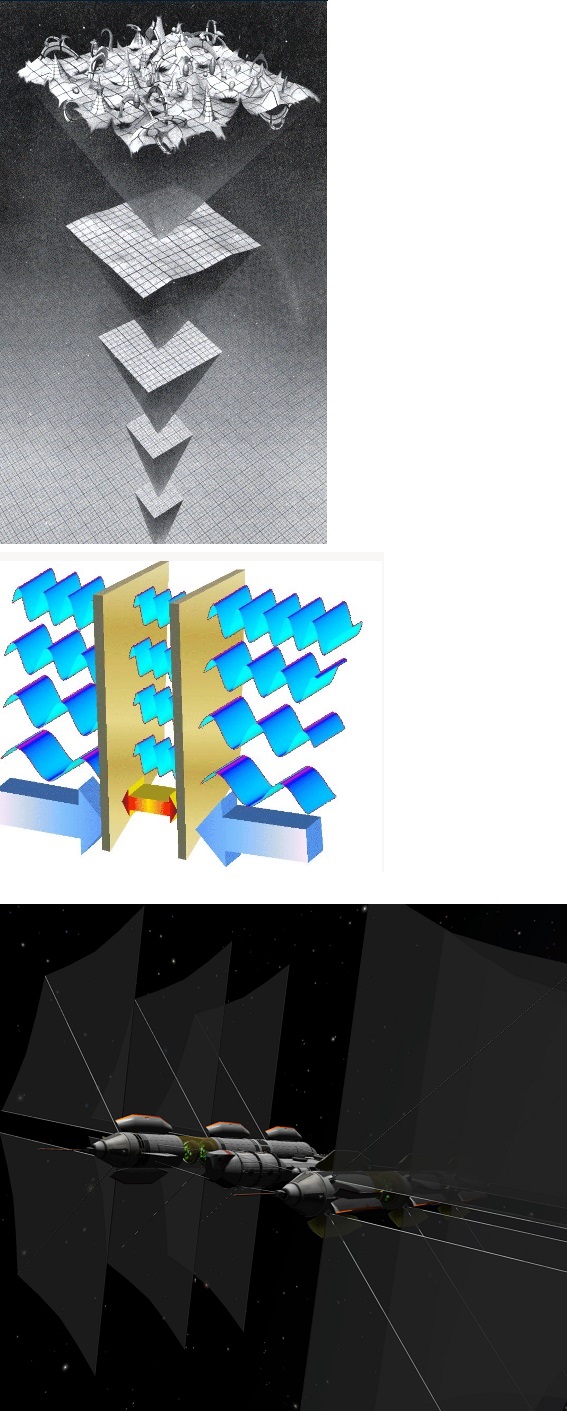
8. Using The Vacuum Energy and ZPE (Status: Speculative)
If "something" really is speculative..., also depends to who you are talking to.That holds for all sorts of things in normal life, but it's certainly also true for physical entities and concepts.
Most of the stuff below, is not as much "speculative", but at the same time, we might say that still no complete theory accounts for the observed phenomena.
However, wat really "looks" speculative, are theories or proposals, that claim it's possible to extract usable Energy from the Vacuum, and use it (for example) as a means of propulsion of a spacecraft. That's not to say that it's impossible. It's just not proven, or likely to be possible, and therefore, it's unfortunately speculative.
And believe me, I for sure would like such technology to be a reality.
I you would get "energy" for "free" (from the Vacuum), would that then violate laws from Thermodynamics? That probably still remains
an open question, I believe.
For physicists and cosmologists, the "Vacuum" is a "strange place" and still not fully understood.
For example, let me shortly describe just a few "characteristics" of the Vacuum, which many physicists really believe to be true, although interpretations and theoretical descriptions can vary enormously.
- There is quite some consensus, that in the early phase of the creation of the Universe, in the Inflationary model, at some point, the Vacuum sits in a higher potential state, which is called the "false" Vacuum. The potential then "rolled down" from that state, which gave rise to various fields and particles. From that point on, then a more "familiar" Universe starts to form.
It's not absolutely certain, that we have a "true Vacuum state" since then. That is, it might roll down further, and maybe it is slowly doing that right now.
(It's not my theory. It's a hypothesis that still is present in the minds of some, but not all, physicists.)
- There are many "clues" that point to the fact that "virtual particles" continuously pop-up from the Vacuum, and immediately destroy each other.
Some speak of "quantum foam", and others relate it also to "zero point energy (ZPE)".
You might interprete these "virtual particles" as "vacuum fluctuations" of "vacuum energy".
Some also relate the effect to the Heisenberg time-energy uncertainty principle.
Those virtual particles might sometimes be viewed "oscillators", and sometimes you may describe them by "fields" or wavelike.
- Also, there are many "clues" that point to the fact that the Universe undergoes a sort of accelerated expansion, as if (from some point in time) some strange "repulsive pressure" is at work.
As to why that happens, a large number of proposals were done, like for example "dark energy", or "quintessence", where the latter is a hypothetical time-dependent field, that at some point started to exert "repulsive" pressure on space.
Some others are investigating what stuff like "Brane cosmology" can offer to explain the effect.
It seems from many articles, that more and more scientists believe that zero point energy or Vacuum Energy is the dominant energy in the Universe, and is actually the main cause of the observed accelerated expansion.
The Casimir effect and related.
When for example two small uncharged metallic plates are placed in a vacuum, at a very short distance from each other, an attractive Force is observed which gets stronger as the distance gets smaller. This effect is called the "Casimir effect".
Other setups (other shapes, or materials etc..) performed in a variety of labs, have shown similar results.
The best explanation today, is that some of the waves associated with the Vacuum Fluctuations (virtual particles), do not "fit" anymore in the space between the plates, while in the space "outside" the plates, all sorts of the usual foamy fluctuations just procede as usual. So the "pressure" inside is lower than the pressure outside. It results in a netto attractive Force, that drives the plates towards each other.
There is not much doubt about this explanation of the Casimir effect in the scientific community.
Since a netto force can be observed, it's extremely tempting to apply it "somehow" in a space drive, or more generally formulated, to extract (or use) Energy from the vacuum fluctuations.
Some speculative proposals to use ZPE, like the "Differential Sail":
One good example might be the Differential Sail proposal. Here, a "sail like" structure utilizes the vacuum fluctuations, by using special materials or geometry of the sail, so that a difference exists in the forces on the front and back of the sail.
Hence, this would lead to a "net force", and thus to propulsion of a spacecraft.
One idea was to make one side of the sail to be more "reflective" to the waves associated with the virtual particles, compared to the other side.
Although the idea may sound fabulous, many folks point to the fact that it breaks established Thermodynamic laws in the sense that we get "free energy" for "nothing" which is not supposed to happen in Nature.
Actually, the idea then more or less falls in the category of "perpetual motion", which is not considered to be possible.
I am not fully sure if that's really true. Many others say simply:
"Don't make a fuss about it with your Thermodynamics. It's just like the wind! On Earth the wind blows your sail and Enery is lost from the wind, and it happens that my boat just gets it, and sails away... It's the same principle here..."
Still some remarks are in order: My comment would be that the fluctuations are so immensly foamy, that it would be very difficult to see that one direction can be singled out using a sail of some sort. So, it's not the problem a Force might act on objects, since the Casimir effect just shows exactly that.
The problem is to let it work for you, that is, to create a net force out of it, in one direction. So, a differential sail and similar proposals probably isn't going to work, I believe. If true, too bad indeed.
But that is just one type of proposal. Who knows what is yet to come?
Many physicists have serious doubts as to make ZPE usefull, for any practical application. However, it's great that some folks don't give up that easily (some physicists included!). Personally, I think that there is much complex theory behind this all, and I think that it cannot be excluded beforehand. But, for now, that's probably more in the realm of speculations than serious science. Well, maybe here I uttered a wrong statement. It is serious science, don't you think so too?
You might google further on ZPE and Differential Sail.
Some other suggestions, and search terms, are "Diode sail" and "Induction sail".
That's real fun!
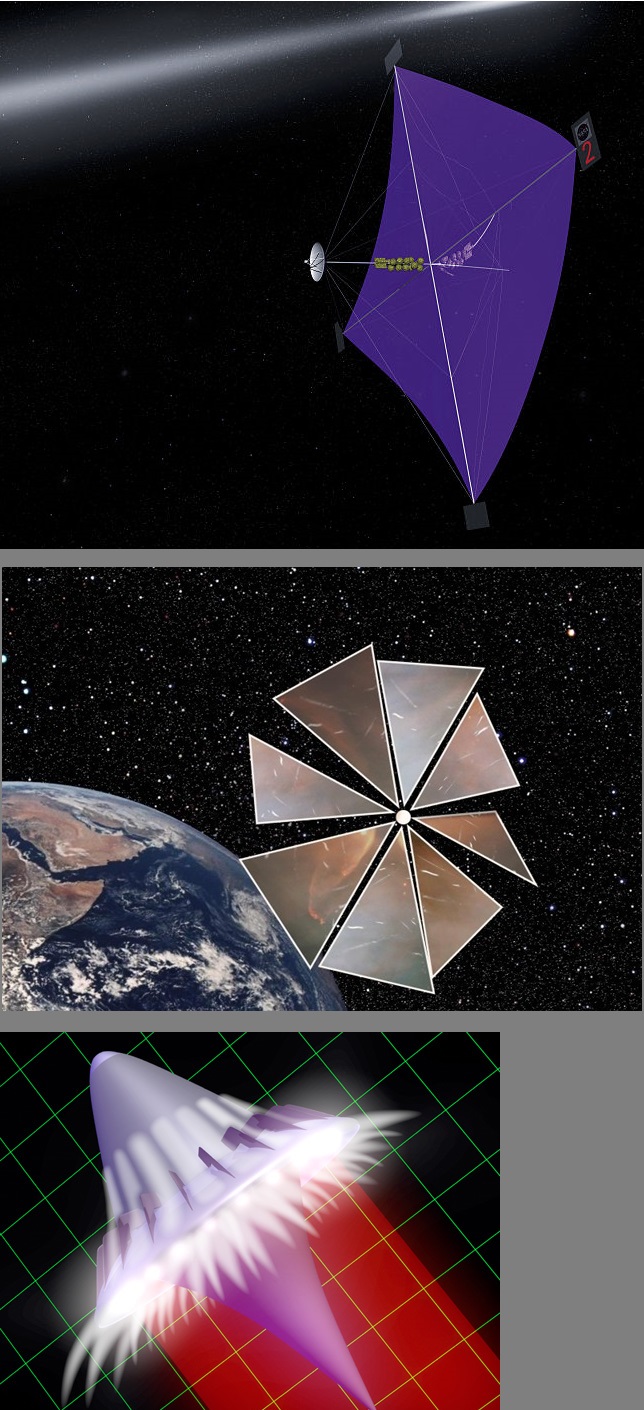
9. Using Solar Sail, or laser propelled (Status: Real)
Here, two fabulous concepts will be discussed. They both are different, but similar in the fact that the spacecraft does not need local propellant (or reaction mass) for propulsion,but contrary, the thrust comes from an external source (either Sunlight or a powerfull Laser).
Spacecraft using a "Solar sail":
A spacecraft using a (large) "solar sail", will be propelled by sunlight! In the first two figures on the left, you might get an impression of such a design.
Such a sail have to be "fairly large" to produce relevant thrust for a larger payload. In general, a square km sail would experience a force of at least 5 Newton when the craft is near Earth's distance from the Sun.
However, also very small "sails" have been implemented in real missions (like IKAROS"), where thrust was definitely proved, and indeed used for the actual mission itself.
For the missions we usually think of, like transporting a relevant payload to the outer planets, a large sail would be neccessary.
The acceleration will be low, but can be applied for a very long time, especially with unmanned missions.
The more "reflective" a sail is, the more momentum transfer can realised from the light of the Sun.
It's reasonable to expect a 90-95% efficiency (instead of a perfect 100% reflective sail), due to slight curvature, absorbance of the Energy, and re-radiation from front of the (thin sail) to the backward side of the sail.
Constructing a large sail of low mass, is ofcourse a technical challenge, but nobody actually doubts that the principle will work.
That such crafts can indeed be quite "fast" is illustrated by an "estimate" using solid foundations. For example, for an optimal machine, a trip to Jupiter might take only 2 years, where the craft is slowly reaching a final velocity in the order of 20 km/s!
Ofcourse, the total force on the spacecraft will drop when the distance to the Sun (r) increases. Initially, you might expect the force to be dependent to a factor like 1/r2.
That's not fully correct. Many variables have influence on the "real force" like the sail's form, orientation, relective %, total surface, controlling surfaces, and much more. The calculations are indeed quite complex.
By using various controls, like sail orientation, shifting the centre of mass, using (smaller) variable reflective liquid crystal panels etc.., orientation and stablization of the machine can be realized.
=> Solar light vs Solar wind:
The Sun is not only a source of light (Solar light). Another "blaze from the Sun", is the socalled "Solar Wind". Instead of photons (light), it's a stream of particles (mostly electrons and protons), that varies over time and also seems to consists of several "sub components" (like the "fast" and "slow" streams).
For reflective propulsion using sails however, the force is much lower compared to Sun light.
Using the "Solar wind" for propulsion, it is argued that a much better implementation would then be a "magnetic sail".
But it's likely that if humanity ever chooses to use any form of Stellar "winds" (either fotonic or particle), you can bet your dollars on the "Solar Sail" implementation. For one, it's quite clear if you would only see the large volume of scientific articles on the subject. It's for sure that "sailing sunlight" has a great potential for missions in the Solar system.
=> Interplanetary- and Interstellar missions:
Solar Sail spacecrafts are real candidates for missions in the Solar System. However, the expected "terminal" velocity when far outside the orbit of Pluto, is way too low to consider it to be a viable system usable for Interstellar missions.
However, using Lasers (or other suitable EM radiation like Microwave) might be a whole other story.
Beam-powered propulsion:
Of this concept, quite a few variations exist. One popular one, uses the idea that a very powerfull laser, or microwave transmitter, "beams" onto the reflective nozzle of a spacecraft, which then undergoes quite a rapid acceleration, for a longer duration.
Many discussions can be found on the "effective range" of that laser "beaming" the spacecraft, and the variations are high.
One important vision suggests that a "many Gigawatt laser" is between the Earth and the Sun, converting the Solar Energy into that high energy laserbeam, propelling the spacecraft.
It's probably fair to say that intuitively, the idea sounds "not too bad at all", but, the technical challenges will be enormous.
The idea is geared towards "Interstellar travel" for nearby star systems.
I will get back to this concept at a later moment, when more details are collected.
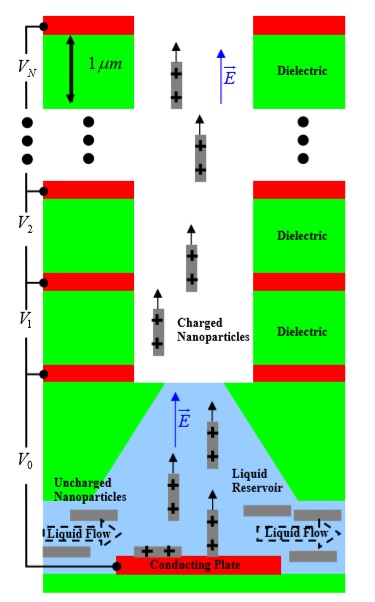
10. Nano particle propulsion, and downsized space crafts (Status: Real)
It's an implementation of "Nano electronic" or "Nanoparticle Electric Propulsion" powered spaceships.Instead of "monster" ships of the former sections, people in the field talk louder and louder on extreme "downsizing" of probes and spaceships. As such materials get lighter, smaller, stronger and more cheaper to produce, the "(usefull payload) : (needed energy)" ratio goes rapidly to the good direction.
There are two, or maybe three, main thoughts here:
- Lightweight Probes that use "nanoparticles" as propellant. If indeed the probe has a very low mass, this seems (according to some articles) as a promising path.
- Extremely downsized probes, using any sort of adequate propulsion mechanism to reach high velocities for deep space missions.
- Extremely downsized probes (like satellites) performing usefull work in "Earth's neighborhood".
For example, experimental work is performed on thrusthers called "Nano-particle field extraction thruster" or "nanoFET"
A nano particle is small, but much heavier than an ion or atom. So, if these can be charged and then accelerated in an Electromagnetic field or "grid", they leave the nanoFET, and also transferring momentum to the probe.
It is reported to have a very high efficiency, but the question remains: for how long? Or, how much "reaction mass" will be available?
A strong point can be the fact that a large number of drives can placed in parallel.
- For Solar system missions, the implementation on probes might be a reality soon.
- For Interstellar missions?
I have seen a number of popular articles covering "interstellar trips", but sofar no scientific documents.
The current overall thrust seems to be in the order of tens, to possibly hundreds of Newton, which is quite low.
If you remember the "ion thruster" of section 3, there the thrust was very low too, but that drive was supposed to operate for months, or even years.
It's not clear right now, how this would be implemented in such Nano spaceships.